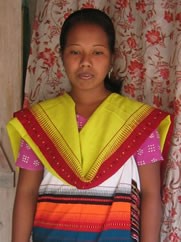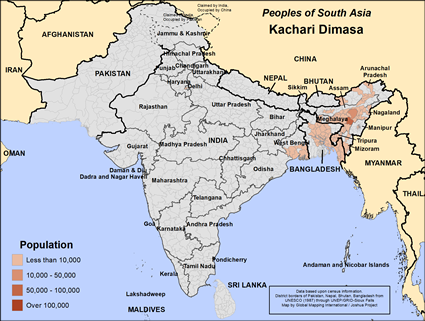Kachari Dimasa in India

Photo Source:
Anonymous
|

Map Source:
People Group data: Omid. Map geography: UNESCO / GMI. Map Design: Joshua Project.
|
| People Name: | Kachari Dimasa |
| Country: | India |
| 10/40 Window: | Yes |
| Population: | 147,000 |
| World Population: | 160,000 |
| Primary Language: | Dimasa |
| Primary Religion: | Hinduism |
| Christian Adherents: | 6.06 % |
| Evangelicals: | 0.00 % |
| Scripture: | New Testament |
| Ministry Resources: | Yes |
| Jesus Film: | Yes |
| Audio Recordings: | Yes |
| People Cluster: | South Asia Tribal - other |
| Affinity Bloc: | South Asian Peoples |
| Progress Level: |
|
Introduction / History
The Kachari Dimasa are a tribal Indo-Mongolian people who live in northeast India. For a thousand years before the British colonial period, they maintained a small kingdom in the lands of the modern states of Assam and Nagaland. The Kachari Dimasa originally came from the southern foothills of the Himalaya Mountains. They left the mountains in search of of better farmland and to avoid warfare.
The name Kachari Dimasa means "children of the great river," the Brahmaputra River. They build their villages near rivers and large streams. The villages consist of from thirty to four hundred buildings made of bamboo and thatch. A tribal chief, a Khunang, has both executive and judicial powers.
The primary occupation of the Kachari Dimasa is farming. At the start of the planting season, they dedicate their rice paddies to their supreme god Madai who is associated with Vishnu or Shiva. They also make bamboo products for sale and raise various kinds of domestic animals.
The main language of the Kachari Dimasa is Deori, also called Dimasa. They also speak Hindi and other languages to communicate with other peoples.
Where Are they Located?
The vast majority of the Kachari Dimasa live in the northeast Indian state of Assam. Others live in Nagaland and other regions of India.
What Are Their Lives Like?
The lives of the Kachari Dimasa revolve around the wet and dry seasons of the Indian subcontinent. In addition to rice, cotton and mustard, they also grow vegetables and fruits for consumption and for sale. The eat meat except for beef.
Sons inherit land and real estate while the daughters inherit their mother's possessions and cooking utensils. Young people cannot marry within their clan or village. Families arrange marriages with the consent of the young persons. Young couples live with or near the groom's parents.
Dancing and instrumental music make up a big part of the Dimasa culture. Men, women, boys and girls all dance and sing at important life rituals and holidays.
What Are Their Beliefs?
The Kachari Dimasa practice their version of Hinduism. Like other Hindus, they believe in the reincarnation of the soul after death. They do not use Brahmin priests in their ceremonies. They have their own priests. Evil spirits are responsible for disease, calamities and suffering. They cremate their dead near a river.
The Kachari Dimasa celebrate festivals different from mainstream Hinduism.
Their main holiday is Bushu, celebrated at the completion of the harvest in late January for a period of ten to twelve days. The participants eat large communal feasts and drink rice beer. Athletic games and parades occur during the days while dancing, singing and music occur at night. People wear traditional clothing and ornaments.
What Are Their Needs?
The Kachari Dimasa need to hear the life-changing gospel of Jesus Christ in a way they can understand. They need a Bible in their language because one does not exist. They must see that Biblical Christianity is vastly superior to the traditional religion. They must see themselves as sinners in need of a Savior.
Prayer Points
Pray that the few Dimasa who are Christians receive training and share the gospel with their brothers and sisters
Pray a Bible is translated into the Dimasa language.
Pray that Lord would move Indian Christians to live among the Dimasa and show them the love and mercy of Christ.
Pray that God raises up a disciple-making movement among the Kachari Dimasa people.